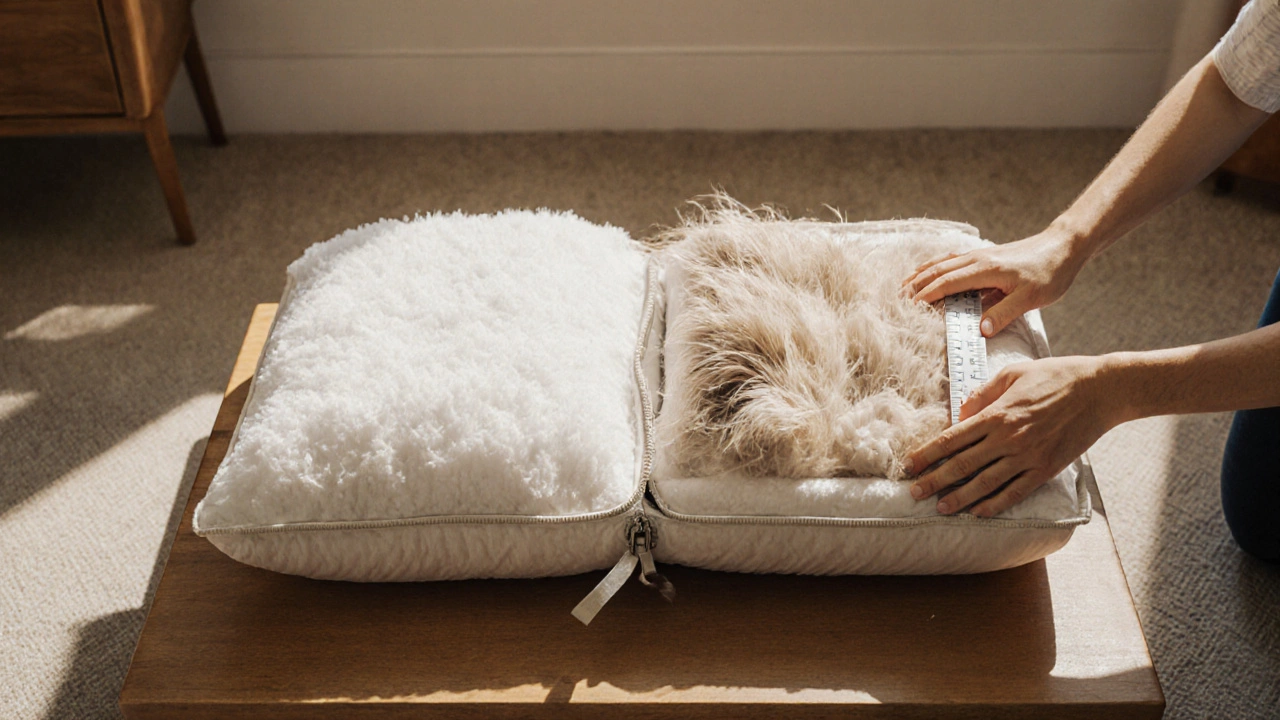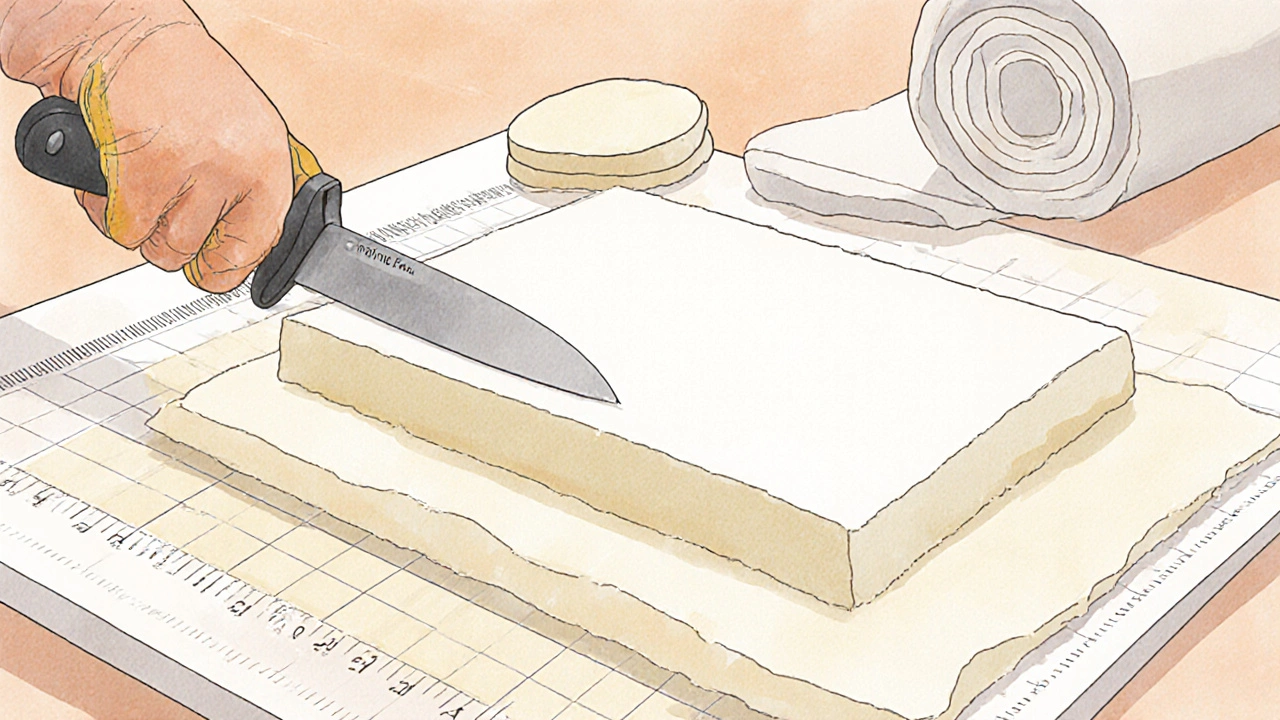
Cushion Revival Cost Estimator
Calculate your cushion revival cost based on the fill material you choose and your cushion dimensions. Estimates are based on New Zealand prices from the article.
Cost Breakdown
When your favorite sofa feels as flat as a pancake, the culprit is usually the couch cushions. Instead of tossing the whole set, you can breathe new life into them with a few affordable tricks. Below are the essential steps, tools, and materials you’ll need to make that old piece feel brand‑new again.
Quick Wins: 5 Immediate Comfort Boosts
- Fluff and rotate cushions weekly to even out wear.
- Slip a thin foam topper between the cushion and its cover.
- Replace sagging batting with high‑density foam.
- Use a spray adhesive to re‑secure loose fibers.
- Cover the entire cushion with a fitted fabric for a fresh look.
Step 1: Inspect What You Have
First, remove the cushion cover and lay the core on a flat surface. Feel for soft spots, lumps, or any broken stitching. Take note of the original fill type - it could be polyester fiberfill, a common low‑cost option that compresses over time, or feather fill, which offers plushness but may clump. Knowing the starting point helps you decide whether to supplement or replace the material entirely.
Step 2: Choose the Right Replacement Fill
Three popular fills strike a balance between softness and support:
| Material | Firmness (1‑10) | Durability | Cost (NZD per sqft) | Best For |
|---|---|---|---|---|
| Memory Foam | 7‑9 | High - maintains shape for years | 8‑12 | People who need firm support, back‑pain sufferers |
| Polyester Fiberfill | 3‑5 | Medium - compresses after 2‑3 years | 2‑4 | Budget‑friendly upgrades, kids' areas |
| Feather Fill | 4‑6 | Low‑Medium - may clump | 5‑7 | Luxury feel, occasional‑use sofas |
If your couch already has a feather core, adding a thin layer of memory foam (2‑inch sheet cut to size) can give you the plushness you love without losing that soft bounce.

Step 3: Cut and Fit New Foam or Batting
Measure the cushion’s length, width, and thickness. Use a sharp utility knife or electric foam cutter for clean edges. When cutting memory foam, remember it’s denser - wear gloves to avoid skin irritation. For a softer feel, you can sandwich a 1‑inch foam layer between two 0.5‑inch batting sheets. This “sandwich method” blends firmness with a gentle surface.
Step 4: Secure the Fill Inside the Cushion
Once the new pieces are cut, place them inside the cushion shell. If the original stitching has opened, stitch it back using a heavy‑duty upholstery needle. For an extra hold, spray a light coat of spray adhesive (fabric‑safe, low‑odor) on the inner walls before inserting the fill. This stops the foam from sliding around when you sit down.
Step 5: Upgrade or Replace the Cushion Cover
A dusty or thin cover can make even the best fill feel uncomfortable. Choose a breathable fabric like cotton‑linen blend or a performance material such as polyester‑spandex for stretch. When sewing the new cover, add a double‑stitched edge for extra durability. If you prefer a quick fix, a fitted slipcover can be slipped on and removed for washing.
Step 6: Add a Protective Layer
To prolong the life of your revamped cushions, consider a thin cushion protector (water‑resistant, breathable) that sits under the cover. It shields against spills, pet hair, and everyday wear, while still letting air circulate.

Maintenance Tips to Keep Your Couch Comfortable
- Rotate cushions every month to avoid uneven compression.
- Vacuum the cover regularly; a handheld brush works for stubborn crumbs.
- Spot‑clean stains promptly with a mild detergent and warm water.
- Every 12‑18 months, give the fill a light shake and fluff to maintain loft.
- Store extra foam in a cool, dry place if you plan future upgrades.
When to Call a Professional Upholsterer
If the couch frame is cracked, the springs are broken, or you need a complex re‑upholstery job (like redesigning the entire look), it’s wise to hire an experienced upholsterer (certified, with a portfolio of completed projects). Their tools and expertise can save you time and ensure the structural integrity of the sofa.
Budget Breakdown: How Much Will It Cost?
Here’s a rough estimate for a typical three‑seat sofa:
- Memory foam sheet (2in×3ft×2ft) - NZD$25
- Polyester batting (1in×3ft×2ft) - NZD$8
- Spray adhesive - NZD$5
- New cushion cover fabric - NZD$15‑$30 per meter
- Optional cushion protector - NZD$12
Total: roughly NZD$70‑$100, a fraction of buying a brand‑new sofa.
Frequently Asked Questions
How often should I replace the foam in my couch cushions?
High‑density memory foam can last 7‑10 years if kept dry and supported. Polyester fiberfill usually needs replacement after 2‑3 years because it compresses more quickly.
Can I use a mattress topper as a cushion filler?
Yes, a thin mattress topper (often made of memory foam) works well as a temporary fix. Just cut it to the exact cushion dimensions and secure it with spray adhesive.
Is feather fill worth the hassle?
Feather fill feels luxurious but requires regular fluffing and can leak through seams. It’s best for guest sofas or decorative pieces that aren’t used daily.
Do I need special tools to cut memory foam?
A sharp utility knife works fine for thin sheets. For thicker blocks, an electric foam cutter or a serrated bread knife gives cleaner cuts and reduces tearing.
How can I keep my couch cushions from smelling?
Air out the cushions weekly, use a fabric deodorizer spray, and ensure the room stays well‑ventilated. Adding a thin layer of activated‑charcoal fabric between the fill and cover can also absorb odors.




